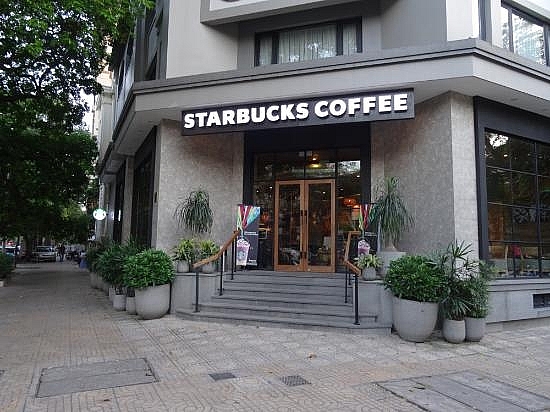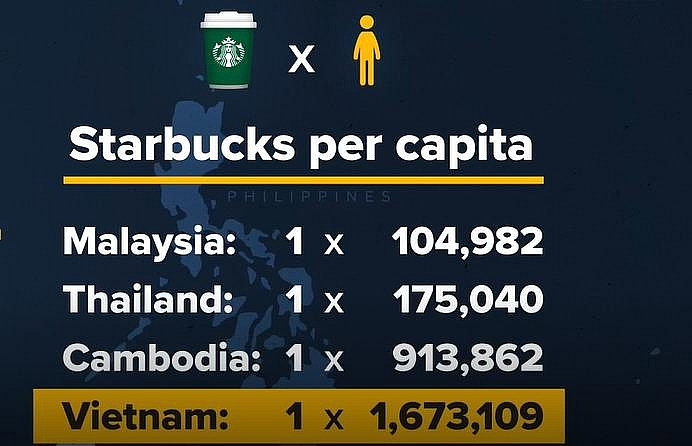Starbucks, Coffee Bean, and Tea Leaf losing to Vietnamese chains
 |
| Of all foreign players, only Starbucks managed to make it into the Top 5 in Vietnam |
Vietnam is the world’s second-largest espresso exporter, according to CNBC. Also, the market is a fierce battlefield for cafe chains. Gloria Jeans, an Australia-based coffee brand which owns about 760 coffee stores in over 65 countries, had to say goodbye to Vietnam after 10 years of trying to conquer the market.
Coffee Bar and Caffe Bene also opened fewer stores than expected. The Kafe, a coffee chain that was well-known in Vietnam years ago, also admitted defeated after three years, despite the $5 million investment from Cassia Investment (Hong Kong).
Starbucks, entering Vietnam in 2013, has one store for every 1.7 million people in Vietnam, which is much lower than other ASEAN countries like Malaysia, Thailand, or Cambodia.
 |
| Starbucks has far less coverage than in regional countries. Source: CNBC |
As the world’s second-largest espresso exporter, Vietnamese people are proud of their legendary thick, heavy brew sweetened with condensed milk.
Vietnamese espresso is brewed from robusta beans, which have a sharper, more bitter taste, and higher caffeine content than arabica. This type of coffee is used by the country from pop-up cafés to well-known coffee chains and even at home.
However, Starbucks – and other Western cafés – brew drinks from arabica and their drink menus do not have Vietnamese consumers favourite drink.
According to Hai Lieu, founder of Letto Coffee & Tea, local cafés understand domestic customers and are better adapted to the market. “Local cafés are flexible in changing their menu. For instance, Highlands Coffee and The Coffee House added bubble tea, which is a popular drink among the young in Vietnam,” he said.
Another reason drinkers spend more time in local cafés is that they offer unlimited and stable Wi-Fi, whereas foreign branded cafés usually limit internet connectivity.
Due to these issues, Starbucks and other foreign branches have been left behind by Highlands Coffee. A report from Euromonitor in last April showed that the five largest coffee chains in Vietnam account for 15.3 per cent of the market, with Highlands holding 7.2 per cent.
Meanwhile, Starbucks is second in revenue thanks to opening new stores that pushed its market share to nearly 3 per cent.
Previously, data from Vietnam Industry Research and Consultancy (VIRAC) showed that Starbucks Vietnam's revenue in 2018 was VND593 billion ($25.78 million), equal to about one-third of Highlands Coffee’s. Meanwhile, The Coffee House came before Starbucks, for the first time, to stand in the second position in revenue with VND669 billion ($29.1 million).
However, the return on sales (ROS) of Starbucks was nearly equivalent to Highlands Coffee (VND27 billion – $1.17 million) in 2018, whereas, The Coffee House only collected VND2 billion ($86,960).
The middle class is rising in Vietnam, and the market value for coffee and tea retailers in Vietnam is greater than $1 billion, according to Euromonitor Worldwide.
Native Vietnamese chains are opening in greater numbers and performing better than their foreign counterparts. Native chains charge much less for espresso, adapt faster, to new traits and have an enormous foothold in the market.
What the stars mean:
★ Poor ★ ★ Promising ★★★ Good ★★★★ Very good ★★★★★ Exceptional
Related Contents
Latest News
More News
- PM orders investment model for North–South high-speed rail (December 22, 2025 | 17:43)
- First members of Danang International Finance Centre revealed (December 22, 2025 | 17:39)
- Securing capital and efficiency for Vietnam’s 2026-2030 growth ambitions (December 17, 2025 | 10:00)
- Driving double-digit growth through green and circular transformation in Vietnam (December 17, 2025 | 09:00)
- Vietnam bucking trend in the global M&A landscape (December 16, 2025 | 14:20)
- Vietnam’s green transition demands collective financial action (December 15, 2025 | 12:00)
- VIR workshop highlights capital and policy for sustainable development (December 15, 2025 | 11:00)
- National Assembly approves pilot mechanisms to accelerate major projects in Hanoi (December 12, 2025 | 11:29)
- Vietnam eases policy approval requirements, simplifies foreign and outbound investments (December 11, 2025 | 17:53)
- Unpacking new momentum in Vietnam’s M&A market (December 10, 2025 | 09:59)

 Tag:
Tag:


























 Mobile Version
Mobile Version